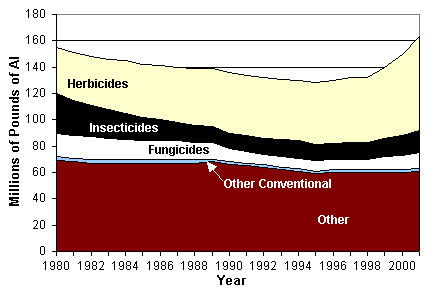Untitled Document
America's lawn-care industry is fighting hard to make sure the nation's
lawns are awash in synthetic fertilizers and pesticides.
 |
An ad from Bayer Environmental
Science. As if toxic pesticides weren't scary enough... |
"I was boarding a flight in Atlanta and a couple of dozen troops with
the 101st Airborne, just back from Iraq, got on the plane. They were all fired
up about being home. I was sitting next to one of the guys. We chatted for a
while, and I asked him what three things he'd missed most over there.
"He listed -- in this order -- green grass, Domino's pizza, and beer.
In that order! I'm telling you, Stan, in this country, with our beautiful lawns
and parks, we take green for granted."
With that anecdote, Den Gardner, executive director of Project
Evergreen, underlined his organization's big message on lawn care: "You
can water, you can put on nutrients, you can use pesticides, and, yes, you can
apply organic products -- if they are used responsibly. And if your kid falls
down and rolls around on a soft, green lawn or soccer field, and doesn't get
hurt -- that didn't happen by chance!"
Gardner and I sat on a park bench in the midst of a vast carpet of green --
not grass, but a real carpet. Tools of the lawn-care trade -- mowers, sprayers,
blowers, sprinklers and spreaders, along with gallon jugs and 50-pound bags
of products to be sprayed, sprinkled and spread -- formed a backdrop stretching
out to what would have been the horizon, had we not been inside the Orlando
Convention Center.
The Green Industry Expo is an annual trade show for the lawn and landscaping
industry. It was held this month in conjunction with a Green Industry Conference
sponsored by the Professional Landcare Network, or PLANET. Project Evergreen
had a small booth and a high profile at the Expo. And its president, Paul McDonough,
spoke at the PLANET conference, declaring that his organization wants to be
"the green industry's 'Got Milk?' campaign."
An ad from Bayer Environmental Science. As if toxic pesticides weren't scary
enough...Gardner told me that from the moment Project Evergreen was formed in
2004, "activists tried to paint us as a front for the pesticide industry.
That really upsets me."
He explained that it's a much broader coalition: "When I started this
group, I called up about 25 people, from the turfgrass industry, golf course
superintendents, sports turf managers, equipment, pesticide, and fertilizer
manufacturers, PLANET, and others. I said, 'Let's get together and talk.'"
"Our goal," says Gardner, "is to set the record straight so
consumers can make their own decisions."
 |
A self-guided mower, because human labor is just too unreliable. (Photo by Stan Cox) |
But Shawnee Hoover, special projects director at the environmental organization
Beyond Pesticides,
insists that Project Evergreen was formed in reaction to an increasing number
of local pesticide bans in Canada. Now, with pesticide and fertilizer regulations
being passed by some U.S. communities as well, Hoover says, "Project Evergreen
is using scare tactics to persuade landscapers that cutting their use of chemicals
will decimate the lawn care industry."
You need only look north, she says, to see that's not true: "In Canada,
where bans on toxic lawn chemicals have been implemented in over 70 municipalities,
the lawn care industry as a whole has continued to grow by 10 percent a year."
Green battlefield
A pesticide-and-fertilizer lobbying group called Responsible Industry for a
Sound Environment (RISE) made news earlier this year, announcing in its "2005
Outlook" report that "We are watching the entire United States, but
particularly the border states of New York, Connecticut, Maine, Wisconsin, Minnesota,
and Washington, for any activity relative to banning pesticides."
That image -- patrolling our border states to interdict and neutralize Canadian-style
environmentalism -- may seem a bit over-the-top, but it's right at home in the
"green industry," where vigilance and struggle are always prominent
themes.
Those themes were strikingly evident in Orlando. The industry's mascot may
be that linchpin of life on earth known as the chlorophyll molecule, but the
Green Industry Expo is all about horsepower, lethality, and hustle. (View scenes
of the 2005 GIE here.)
Let us spray
There's no question that chemistry plays a central role in the American lawn.
According to Project Evergreen's website, 50 percent of households treat their
lawns or gardens with pesticides, applying active ingredients at average annual
rates of 2 pounds per acre for herbicides and 0.4 pounds for insecticides. Professional
applicators apply an average 193 pounds of fertilizer per acre per year, while
do-it-yourself homeowners use 139 pounds.
Because nutrients, especially phosphorus, can run off fertilized yards and
sidewalks into storm drains or escape the shallow roots of turf grasses to pollute
groundwater, some states and communities have restricted fertilizer use.
Contrary to industry claims, a Minnesota study indicated that "lush
lawns are more of a water quality problem than poorer turf lawns,"
because of phosphorus runoff.
But it's pesticides that are the focus of most of the wrangling in Congress,
state legislatures and regulatory agencies these days.
While agricultural use of pesticides has stagnated and industrial use has declined
in recent years, business is booming in the home-and-garden sector. According
to the Environmental Protection Agency's most recent statistics, home herbicide
use almost
doubled between 1982 and 2001.

Every two years, the federal Centers for Disease Control and Prevention (CDC)
report on blood and urine concentrations of a wide variety of synthetic chemicals
in a representative sample of Americans. In the 1999-2000 sampling, 2,4-D (2,4-dichlorophenoxyacetic
acid, one of the most widely used herbicides) was very rare or absent in the urine
of all age groups tested. But the report released in July of this year, covering
surveys from 2001-2002, 2,4-D was present in at least 25 percent of samples tested.
Anti-pesticide activists are forcefully targeting 2,4-D, citing a multitude
of studies from the scientific literature they say demonstrate its toxicity
to humans and other animals. Increased rates of lymphoma and bladder cancer
have even been found among dogs whose owners use 2,4-D.
And Beyond Pesticides cites published
research showing that 29 of the 30 most commonly used lawn pesticides are
toxic to birds, fish, amphibians, and/or bees.
 |
A scene from the Green Industry Expo. This is the Hummer of fertilizers. (Photo by Stan Cox) |
In an appendix to its congressional testimony against a bill that would loosen
restrictions on pesticides under the Clean Water Act, Beyond Pesticides listed
summaries of a dozen studies from the mainstream scientific literature showing
adverse health effects of pyrethroids (a popular class of home-use insecticides
that the CDC also now finds common in human urine samples) on mice, rats, amphibians,
lobsters, and humans.
In contrast, I had seen on Project Evergreen's website a number of information
sheets citing the scientific literature and declaring pesticides generally safe
if used correctly. But Den Gardner told me, "We're a 501(c)3 nonprofit,
and not beholden to any interest groups. It's not our job to endorse any particular
piece of research. There are no scientists in our organization."
There is no law against nonprofit groups evaluating research. And lack of scientific
credentials has not stopped Project Evergreen from speaking out against local
natural-lawn initiatives.
When communities on Boston's North Shore joined in an effort to curb chemical
use, not by banning home pesticide use but simply through workshops on chemical-free
lawn care led by medical and organic experts, Gardner complained to a Boston
Globe reporter about misinformation
from some activists."
Project Evergreen often turns to the scientific community for backup. In the
group's tip sheet, "Banishing Pesky Pests to Create a Lush Lawn,"
associate professor Parwinder Grewal of Ohio State University explains the importance
of treating early and often with pesticides: "It is too late for grub control
when skunks have started digging the turf in search of a nice meal of fully
developed, juicy grub larvae."
Shawnee Hoover says, "Project Evergreen has shown that it is fiercely
against any kind of regulation of toxic chemicals. Isn't that a little strange
for a group supposedly only concernedwith the benefits of green landscapes?
"It's a deceptive front. It doesn't represent the interests of the public,
it represents the interests of the chemical industry, including RISE, Dow, Bayer,
and Syngenta."
All of those, she says, were on a membership list that has since been removed
from the organization's website.
Says Hoover, "Project Evergreen epitomizes the definition of 'greenwashing'."
From the farm to the lawn
In a 2003 paper published in the journal Antipode, Paul Robbins and Julie Sharp
of Ohio State University's Geography Department noted that, "Profits from
agricultural pesticides have been low for years," sending agrochemical
manufacturers in search of new markets. Today, "their most reliable customers"
are the makers of lawn-care products, who, in turn, are working to "increase
the ranks of chemical-using lawn managers."
Robbins and Sharp concluded, "Changes in the broader economy of agricultural
chemical manufacturing have paved the way for increases in the sales of lawn
chemicals."
Indeed, most of the products that were being promoted by Monsanto, Dow, Syngenta,
Bayer and other companies at the Green Industry Expo have the same active ingredients
as common agricultural pesticides. And, thanks to the National Institutes of
Health and EPA, there is now a huge body of epidemiological data on effects
of exposure to ag chemicals.
In an NIH/EPA Agricultural Health Study that has been running since 1993, scientists
have monitored the health of private and commercial pesticide applicators and
spouses. Almost 90,000 people have been included in the continuing study.
When I asked one of the project's leaders, Dr. Aaron Blair of the National
Cancer Institute, what has been learned so far, he summed up the situation this
way: "Evidence from experimental and epidemiological studies suggests that
some agricultural chemicals present risks to humans, but the magnitude of risk
and specific exposures have not yet been well characterized. Outcomes of concern
include cancer, neurologic diseases, reproductive problems, nonmalignant respiratory
diseases, and injuries."
Green that brings in the green
A burgeoning chemical-free-lawn movement is offering
loads of advice on alternative management of lawns, gardens and parks. But
experts emphasize that it's not simply a matter of substituting this organic
product for that synthetic one. Whole ecosystems have to be encouraged to regenerate,
and that doesn't happen overnight.
The whole-ecosystem approach also doesn't generate enough of that kind of green
that keeps the "green industry" going. As Robbins and Sharp put it
in their paper, "Any truly sustainable alternative is, put simply, bad
for business."
The Green Industry Expo is not the place to go to find stuff that's bad for
business; there was no reason to expect that any company would be there to urge
lawn-care providers to cut back on their purchased inputs and let nature take
over. But, I figured, somebody must at least be trying to cash in on environmental
concerns.
Weaving my way through rank after rank of mammoth, zero-turning-radius lawnmowers
-- the typical specimen resembling a hybrid between a lunar rover and a La-Z-Boy
recliner -- I searched for lawn-care approaches in a different shade of green..
LESCO of Cleveland, Ohio is one of the industry's major input suppliers. At
the sprawling LESCO display, marketing director Bob West told me that his company
does have an "Ecossentials" line of products, but he's seen "minimal
demand in isolated areas -- and you can probably guess where those areas are."
He grinned.
"Look at Cape Cod, where there's more sensitivity about environmental
issues. Our customers, the lawncare guys, might come in and ask for an organic
product because one of their customers, a homeowner, requested it. More often
than not, they'll end up going back to their traditional product. They find
out, one, that it costs more; two, that it takes longer to see results; and
three, they don't get the same level of results.
"It's a toughie. People say one thing with their emotions, another with
their wallet."
I sat through a PLANET workshop on "best practices," waiting in vain
for a discussion of thrift and restraint in chemical use. Speaker Bruce Wilson
of the Wilson-Oyler Group did mention worker-safety training, but the focus
was on vehicles and equipment.
Wilson had his own version of a three-item list: "Customers want to see
green grass, beautiful flowers, and no weeds. If those things are in place,
they're not looking at other stuff."
I resumed my search for alternatives, deep into shadows cast by the towering
John Deere, Dow and Monsanto displays. And here and there I hit pay dirt, so
to speak.
Gabe Diaz-Saavedra of Nature Safe Natural and Organic Fertilizers: "It's
a high-end niche market. Most typically not middle-class, but upper-class homes.
And you don't get that instant response a lot of people like. For instance,
it takes eight to 12 weeks to see disease suppression."
Tammy Kovar Dorton of Plant Health Care, whose products include fungal and
bacterial soil inoculants: "Green laws [that ban synthetic chemicals] are
helping, but it's a slow evolution."
Greg Gill of Nutrients Plus, which sells blends of poultry compost, biosolids
(i.e., sewage sludge), and standard synthetic fertilizers: "We're not tree-huggers.
We try to sell the best fertilizer, and environmental benefits like disease
and pest suppression are just icing on the cake. But most customers require
synthetic fertilizer in the mix, for aesthetic reasons. When they see that fertilizer
go down, they want to see green in a few days."
Who tells the story?
Last year, Project Evergreen put out an advertisement in the trade press, telling
the lawn and garden industry that "legislation and regulations have been
throwing the green industry some rough punches. And we're about to start fighting
back." The ad featured a pair of well-worn leather work gloves and a pugnacious
punchline: "The Gloves Are Off."
In line with what seems to be Project Evergreen strategy, there was no mention
of pesticides or synthetic fertilizers in the ad -- only a parenthetic comment
about "resources (such as water)." But it was widely viewed as an
effort by big corporations to fight local pesticide bans.
Beyond Pesticides countered with a parody of "The Gloves Are Off"
entitled "Get a Grip," in which a pair of flower-patterned garden
gloves lay on a lawn just as green (pdf
of both ads). It read, "The chemical lawn-care industry is worried that
the word is getting out on the toxic hazards of lawn pesticides."
Den Gardner admitted that the Project Evergreen ad was probably too aggressive.
"It was intended for landscape, lawncare, and other end-user businesses.
It was never intended as a consumer campaign. But activists took it and ran
with it. We learned there's no such thing as an internal issue in this business."
"But," said Gardner, looking on the bright side, "it also gave
us instant notoriety!"
He showed me the centerpiece of his group's new, and very different, campaign:
a photograph in which two young children sit on a manicured lawn, looking at
an empty Adirondack chair. On the arm of the chair lies a book titled "Because
Green Matters." The ad asks, "Who's telling your story?"
I asked Gardner how this campaign is being received in the "green industry."
He smiled. "It's resonating well."
Condition green
In their study of the lawn-chemical economy, Robbins and Sharp noted that "property
values are clearly associated with high-input green-lawn maintenance and use,"
and that "moreover, lawn-chemical users typically associated moral character
and social responsibility with the condition of the lawn."
Those are the economic and social buttons that the lawn-product makers and
Project Evergreen are pushing as they try to convince the "green industry,"
and you, that without constant vigilance, struggle, expense, and inevitably,
a bit of industrial chemistry, the world would fade to black, white and sepia
tones. Skunks would roam your front yard, feasting on fat, white grubs; you'd
see your kid limp home after playing soccer in a hard, dusty vacant lot; your
once-lush suburb would start to look like Sadr City.
That vision, however, is nowhere near as frightening as the toxic, ecologically
impoverished future envisioned by anti-pesticide activists. And the turf war
is on. Rounding a corner on the final day of the Expo, I came face to face with
a large photo of a helmeted soldier. Glaring through a slot in a concrete bunker,
he urged, "Defend your turf with Cavalcade. Make Cavalcade your weed control
weapon of choice this spring."
Except for the camouflage on his face and helmet, there was no green in the
picture.
Stan Cox is a plant breeder and writer in Salina,
Kansas. Since this past July, his
front lawn been lawn-free.

